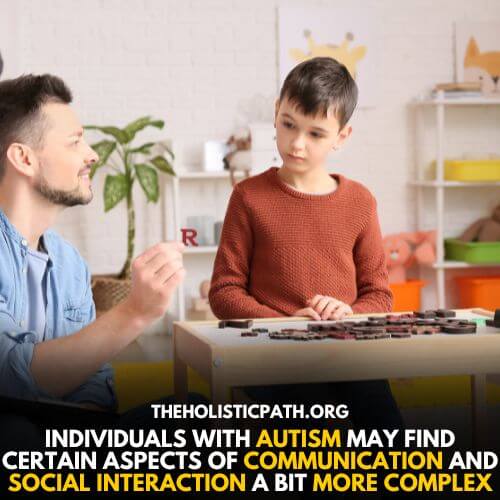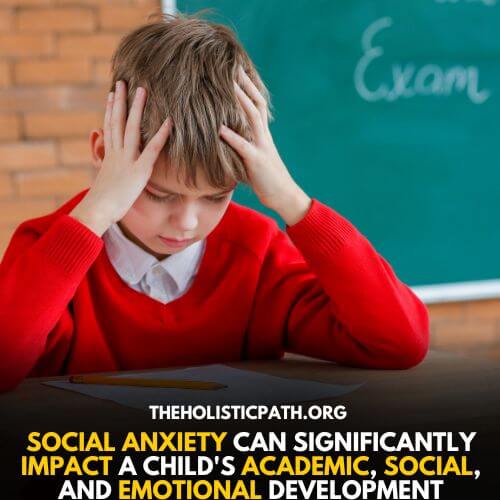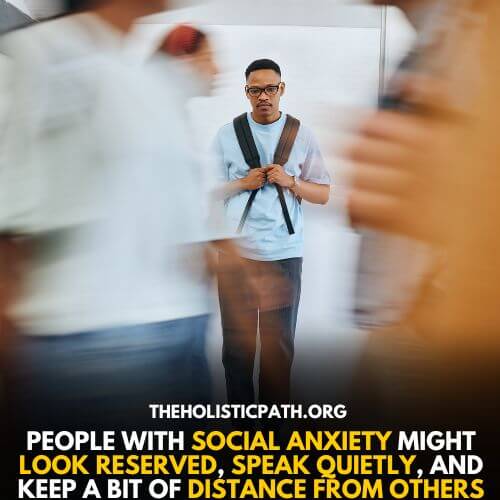Navigating the world of social interactions can be tricky, especially for those dealing with challenges like autism and social anxiety. These two conditions, though different, often affect how individuals connect with others.
It’s like unraveling a puzzle – understanding the contrasts between autism and social anxiety is crucial for offering the right support.
In this article, we’ll break down the basics of autism vs. social anxiety, exploring how each condition influences the way people socialize. Let’s dive into the simple yet often misunderstood aspects of these unique behaviors.
Autism vs Social Anxiety
Autism and social anxiety, though distinct, can share similarities, often leading to misdiagnoses, especially in high-functioning individuals who may mask their symptoms.
Autism is a neurodevelopmental disorder affecting social communication and behavior, while social anxiety is a mental health condition characterized by an intense fear of social situations. The co-occurrence of anxiety and autism is not uncommon, and individuals with high-functioning autism may initially be diagnosed with social anxiety due to overlapping symptoms.
Understanding the differences between these conditions is crucial for accurate diagnosis and tailored support. Both developmental and mental health aspects need consideration to address the unique needs of individuals with autism and social anxiety.
Social Anxiety vs Autism Comorbidity
Social anxiety disorder (SAD) and autism spectrum disorder (ASD) are two distinct conditions, but they can sometimes coexist, presenting a unique set of challenges for individuals. Let’s explore some of the key overlapping aspects of autism and social anxiety:
Understanding Social Anxiety
Social anxiety is a psychological condition. It’s characterized by an intense fear of social situations and interactions. You often find yourself grappling with excessive self-consciousness and a fear of judgment.
There’s a persistent worry about being embarrassed or humiliated in social settings.
This anxiety significantly affects your ability to form and maintain relationships, participate in group activities, and engage in everyday social interactions.
Symptoms of Social Anxiety
People with social anxiety may exhibit a range of symptoms that can manifest in various social contexts. Common symptoms include:
- Excessive self-consciousness
- Fear of humiliation or embarrassment
- Avoidance of social situations
- Physical symptoms like trembling, sweating, and nausea
Causes of Social Anxiety
The origins of social anxiety are complex, and influenced by various factors:
| Contributing Factors | Description |
|---|---|
| Genetic Predisposition | Inherited traits may play a role in predisposing individuals to social anxiety. |
| Brain Structure and Function | Differences in brain structure and function, particularly in areas related to fear and social perception, can contribute. |
| Environmental Factors | The environment, such as a highly critical or judgmental social context, may contribute to the development of social anxiety. |
| Early Life Experiences | Negative social experiences, including a history of bullying, can shape the development of social anxiety. |
These factors interact in complex ways, influencing the onset and severity of social anxiety in individuals.

Understanding Autism Spectrum Disorder (ASD)
Autism, also known as Autism Spectrum Disorder (ASD), is a unique way of experiencing the world that brings its own set of challenges. Individuals with autism may find certain aspects of communication and social interaction a bit more complex. Some might have intense interests and engage in repetitive behaviors.
Sensitivities to things like lights, sounds, or textures can be more pronounced.
Changes in routine may be particularly challenging. It’s important to recognize that autism doesn’t look the same for everyone. Providing support tailored to individual needs and understanding their perspective is key.
Core Features of ASD
Core features of Autism Spectrum Disorder include:
- Impaired social communication
- Restricted and repetitive behaviors
- Sensory sensitivities
- Difficulty in understanding social cues
Comorbidity of Social Anxiety and Autism
Overlap in Symptoms
When someone has both social anxiety and autism, it makes things a bit tricky. Imagine trying to understand social situations when communication is hard (that’s autism) and, on top of that, feeling nervous around people (that’s social anxiety). It’s like having a double challenge.
Because of this combo, people might find social stuff extra tough.
They could get extra stressed in social situations because of both anxiety and the struggle to figure out social cues. This mix can also make it harder for them to connect with others, leading to more feelings of being alone. To help, doctors and support teams need to understand these double challenges and find ways to support individuals in dealing with both social anxiety and autism.
Challenges in Diagnosis
Impact on Daily Functioning
Autism vs Social Anxiety: 8 Key Differences
Social anxiety and autism are different conditions, even though they might look similar in some ways. It’s important to know these differences for the right diagnosis and support.
1. Eye Contact:
In social anxiety, avoiding eye contact is often linked to a fear of being negatively judged or embarrassed in social settings. This avoidance stems from a heightened self-consciousness that makes looking into others’ eyes uncomfortable.
On the other hand, for individuals with autism, challenges with eye contact may be rooted in sensory sensitivities, difficulties in social communication, or struggles with interpreting nonverbal cues. The discomfort in making eye contact is not primarily driven by a fear of judgment but rather by different sensory and social factors.
2. Social Motivation:
Social anxiety is characterized by a strong fear of negative evaluation, prompting individuals to steer clear of social situations. The motivation to avoid social interactions arises from the anticipation of being scrutinized or criticized by others.
In contrast, individuals with autism exhibit a diverse range of social motivations. Some may have a genuine desire for social connections but encounter obstacles in forming and maintaining them due to difficulties in understanding social cues or engaging in reciprocal communication.
The challenges in social motivation for those with autism are not solely rooted in fear but involve complex social skill difficulties.
5. Body Language:
When dealing with social anxiety, individuals often become super tuned in to the body language of others. It’s like they have a heightened sensitivity to the unspoken signals people send.
On the other hand, for someone with stereotypical Autism, grasping the meaning behind others’ body language might not come naturally—it’s a bit like trying to crack a code.
Now, for high-maskers on the Autism spectrum, things get more intricate. They might seem extra aware of emotional tones, giving the impression of intuitively understanding body language.
But it’s not a gut feeling; instead, they might use their prefrontal cortex, to carefully study and decipher body language. It’s like they’re solving a puzzle rather than effortlessly picking up on social cues.
6. Brain Function:
In autism, the brain often has atypical connectivity and communication between different regions, especially those involved in social understanding. This can lead to challenges in social interaction, communication, and repetitive behaviors.
On the other hand, in social anxiety, there is heightened activity in brain regions associated with fear and stress, particularly the amygdala. This heightened activity can cause individuals with social anxiety to feel intense fear and discomfort in social situations.
While both conditions involve difficulties in social aspects, the underlying brain mechanisms differ.
Autism and Social Anxiety in Children
Understanding the distinction between anxiety and autism in children is crucial for accurate diagnosis and appropriate intervention. Let’s delve into the characteristics of each to help clarify the differences:
Social Anxiety in Children:
Social anxiety disorder (SAD) is characterized by an intense fear of social situations, particularly those that involve performance or evaluation by others. In children, this fear can manifest in various settings, such as school, extracurricular activities, or social events.
Key Characteristics:
- Fear of Negative Evaluation: Children with social anxiety often fear being judged or criticized by others. This fear can hinder their ability to engage in social interactions, participate in class, or make friends.
- Avoidance Behaviors: To cope with their anxiety, children with social anxiety may engage in avoidance behaviors. This could involve skipping social events, avoiding eye contact, or refraining from speaking in class.
- Physical Symptoms: Anxiety can manifest physically, leading to symptoms such as sweating, trembling, stomachaches, or headaches, especially when faced with social situations.
Impact on Functioning: Social anxiety can significantly impact a child’s academic, social, and emotional development. It may lead to academic underachievement, difficulty forming relationships, and an increased risk of developing other mental health issues if left unaddressed.

Autism Spectrum Disorder (ASD) in Children:
Autism is a neurodevelopmental disorder characterized by challenges in social communication and interaction, as well as restricted and repetitive behaviors. While social difficulties are a hallmark feature of autism, it’s important to recognize that these challenges are distinct from social anxiety.
Key Characteristics:
- Social Communication Challenges: Children with autism may struggle with nonverbal communication, such as maintaining eye contact, understanding social cues, and engaging in reciprocal conversations.
- Repetitive Behaviors: Autism often involves repetitive behaviors or intense interests. Children may display repetitive movements (e.g., hand-flapping), insistence on sameness, or fixations on specific topics.
- Sensory Sensitivities: Many autistic children experience heightened sensitivities to sensory stimuli, such as lights, sounds, or textures.
Impact on Functioning: Autism can affect various aspects of a child’s life, including academic achievement, social relationships, and daily functioning. Early intervention and tailored support are crucial to help children with autism navigate these challenges and reach their full potential.
8 Easy Strategies for Dealing With Autism and Social Anxiety
Dealing with both autism and social anxiety requires a thoughtful and individualized approach. Here are some general strategies that may help:
-
Social Skills Training: Engage in social skills training programs that focus on teaching and practicing social cues, conversation skills, and appropriate social behaviors. This can help individuals with autism navigate social situations more comfortably.
-
Gradual Exposure: Gradual exposure to social situations can help reduce anxiety. Start with smaller, less overwhelming social settings and gradually work up to more complex interactions. This allows individuals to build confidence and coping mechanisms over time.
-
Visual Supports: Visual supports, such as social stories or visual schedules, can be beneficial for individuals with autism. These tools provide a visual guide to social expectations and can help reduce anxiety by offering a clear structure.
-
Therapeutic Support: Cognitive-behavioral therapy (CBT) is often effective in addressing social anxiety. Therapists can work with individuals to identify and challenge negative thought patterns, develop coping strategies, and gradually face feared social situations.
-
Establish Routine and Predictability: Individuals with autism often benefit from routines and predictability. Establishing a consistent daily routine can provide a sense of stability and reduce anxiety associated with unexpected changes.
-
Peer Support Groups: Joining support groups or social clubs specifically designed for individuals with autism can offer a supportive environment for practicing social skills, sharing experiences, and building connections with others who may face similar challenges.
-
Communication Strategies: For those with difficulty in social communication, using clear and direct communication strategies can be helpful. Encourage the use of visual supports, gestures, or technology to enhance communication.
-
Sensory Considerations: Be mindful of sensory sensitivities that individuals with autism may experience. Creating environments that accommodate sensory needs can contribute to a more comfortable and less anxiety-provoking experience.
Remember, it’s crucial to tailor these strategies to the specific needs and preferences of the individual. Consulting with professionals, such as therapists or behavioral specialists, can provide personalized guidance and support.
Conclusion
It’s important to know that dealing with both autism and social anxiety can be tough, but understanding each person’s unique challenges helps in offering the right kind of help. By being aware and finding ways that suit each individual, we can create a world where people with both autism and social anxiety can feel good, connect with others, and live their best lives.
References
Spain, D., Zıvralı Yarar, E., & Happé, F. (2020). Social anxiety in adults with autism: a qualitative study. International Journal of Qualitative Studies on Health and Well-Being, 15(1), 1803669. https://doi.org/10.1080/17482631.2020.1803669
Guy-Evans, O. (2021, June 16). Differences Between Social Anxiety and Autism – Simply Psychology. https://www.simplypsychology.org/social-anxiety-vs-autism.html

